Social Media Campaign

Campaign Overview
For this project, I was tasked with creating a social media campaign representing ourselves and showing projects and other work among other things. The campaign had to be run on Linkedin as well as another social media platform of our choosing. The goal of this campaign was to create a presence for myself in the industry and potentially aid me in employment.
Goals
- My first goal is to reach other creatives. I find it very important to be a part of the community of digital media designers as it means being surrounded by support and feedback.
- Another important goal is to reach potential employers. Of all the groups that I am hoping to attract with this campaign, employers would be the most valuable with the objective of finding a career.
- I also would like to grow my personal brand. Social media is one of the best ways to display your personality in your work. I would like to gain 50 followers by submission.
- Displaying my projects will also be important as it shows my skills to my viewers and it will make up the majority of my content.
- I would like to tell the story of Elizabeth Peacock. Elizabeth Peacock is the subject of a project I am working on this semester. She was a witch who lived in Malmesbury in the 17th century. Since many of my posts will be related to her and my 3D interpretation of her house, I feel it is important for my social media campaign to tell her story for educational purposes and to provide context to my project.
- Finally, I would like my project to increase the number of visitors to Malmesbury through my Elizabeth Peacock content.
Choosing the platform
I considered many options when choosing a platform for my campaign. The obvious choices to consider were platforms which have massive popularity like Twitter, Instagram, Facebook and Tiktok.

I found Instagram to be the most appealing of all the mainstream social media platforms. It shares many features with facebook whilst making them different enough to be more suitable for my campaign. When posting on Instagram, you are required to upload an image. This emphasis on images is carried across the whole platform. When a post shows on your feed, 100% of the width of the post is taken up by the image and around 75% of the height of most posts as well. The image is put completely front and centre. This will work very well for me as I plan on using images to catch the attention of my viewers. Posts also show on your profile with only the image, organised in a grid. Instagram also uses features like the home page which is a great way to find new content from profiles you may have never previously heard of. Utilising the right hashtags may result in appearing on the home page of similar minded people or it may help you break into specific communities. Instagram's Reels feature is also very useful for reaching new people. Much like TikTok, Instagram Reels uses a complex algorithm to connect a user with content related to their interests.

Another platform I was able to quickly rule out was Twitter. Although Twitter would accommodate my content more than Facebook due to its increased number of creatives on the platform, Twitter has a clear emphasis on saying things instead of showing things. If I were to post an image to display some of my work, the “caption” for that image appears above in large text whereas the image appears in a box that doesn't scale to the edges of the screen, not making the most of the space to properly display the image. As well as this, posting multiple images in one post will result in them being cropped in order to fit until the image is clicked on where the whole image will be revealed. This does provide the advantage of having all images partially visible when it appears on your feed. It means that none of the images are as immediately eye-catching as on Instagram for example where the images are presented in a carousel. Just like Facebook, these aren't flaws in the platform but instead, intentional choices. The platform just isn't fit for the purpose of my campaign.

Tiktok
The last of the mainstream platforms I explored was Tiktok. Tiktok as a platform is very similar to the reels feature built into Instagram. It shows people content based on posts they have interacted with in the past. Whilst this system is excellent at bringing you content that you may have never found searching on your own, Instagram would provide that for me amongst many other important features. Another issue I found with Tiktok is the younger demographic. Although I aim to reach the younger demographic with my campaign, 60% of Tiktoks users are between the ages of 16 to 24 meaning Tiktok is a great platform for reaching a younger demographic but would not be as effective otherwise.

Immediately I decided to rule out Facebook for a few reasons. Firstly, Facebook has more of an emphasis on interacting with friends than reaching new viewers. In 2015 Facebook announced changes to their algorithm that would prioritise posts from accounts on your friends list over any other post. Where Facebook shares a lot of features with other social media like Instagram, when using Facebook, you can easily see the focus is on friends. Since both companies are owned by Meta, I believe this is an intentional choice. Facebook just isn't designed for the type of campaign I'll be running. As well as this, Facebook's appearance, layout and algorithm change at a higher rate than other social media which means it's not a stable platform to build a social media strategy.
Design Specific Social Media Platforms
Finally, I also considered a few specialities social media platforms made specifically for design including Artstation and Behance. Although these platforms are built from the ground up to accommodate designers, I was looking for a platform that would provide me with many different audiences, not just specific to design.
Based on my research I have concluded that Instagram is the best fit for my social media campaign.
Time Of Posting

This graph shows the best times to post on Instagram using the number of active users. The graph shows a lower number of active users in the morning from 6 AM until 9 or 10 AM depending on the day. The graph also shows a pattern of a lower number of active accounts, earlier in the morning the closer we get to the end of the week. I chose 5 PM as my target upload time as it not only fits comfortably in the time period each day with the most active users but it also fits my schedule well. I chose Wednesday and Sunday as my upload days. The graph shows that weekdays are the best days to post since they have higher numbers of active users for a larger time period which is why I chose Wednesday. I also chose Sunday in order to space my posts out. Although Sunday has a lower portion of the day with high active users, I will be uploading at the peak of the day to compensate. Despite the data in this table, websites like Hootsuite recommend posting between 8 AM and noon. Taking this on board, I will also experiment with posting earlier in the day, even if it does contradict my other research.

Linkedin is a business social media so the best time of day to upload is no surprise. This graph shows engagement at different times of day, each day of the week. The graph shows the highest engagement is during the standard workday from 8 AM until 4 or 5 PM. You can also see that many Linkedin users use the app after they have finished work between 5 and 8 in the afternoon when engagement is still high but not at its peak. Unlike Instagram, it is clear that the best time to post is in the morning. I plan to post around 10 AM. The best days of the week to upload include every weekday except for Monday when engagement drops a small amount in the early morning and mid-afternoon. The biggest takeaway from this graph is that it would be a good idea to avoid uploading on a weekend, especially on Sunday. Linked users appear to have a break when they aren't at work or haven't just finished work.

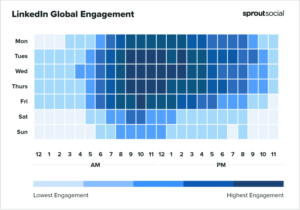
Social Media Examples
When researching for this project I came across many social media campaigns which I found inspiring.
Viral Campaigns
Spotify Wrapped
Spotify Wrapped is my favourite social media campaign. From a consumer’s point of view, it is valuable to be given something back when being advertised to. Spotify releases yearly automatically personalised “stories” showing a recap of the user’s year on Spotify. The personalised nature of the campaign makes it feel thoughtful despite being automatically generated and designed to market its product. Making users aware of their statistics naturally makes them want to compete. Music listeners can be very loyal to artists so if they fall in the top 1% of most listens of a specific artist, they will want to share that on social media. Spotify addresses this by giving the user a single image including all of the most impressive statistics that they can share wherever they want. This campaign is so effective that the release of Wrapped has become a yearly event in the music community. Fans will talk about Spotify Wrapped on Twitter and other social media in the build-up to its release, further marketing Spotify as a product. This campaign taught me that people love to discuss competition and hype generates a lot of conversation too.
Shot On iPhone
Shot on iPhone is a very simple campaign where Apple challenged their customers to share images that had been taken on their range of iPhones using the hashtag #ShotoniPhone. Apple would then review the submissions and use them in advertisements like on billboards or in video adverts or use them in their stores. Apple has used an effective strategy of showing not telling. This campaign rarely mentions how impressive their cameras are, they just provide a platform for their users to show it. The fact that the content being shared is from Apple’s customers builds more trust in the validity of the marketing compared to if Apple took the photos themselves. This campaign taught me the power of hashtags, not only to benefit Apple but also for the creators that used the hashtag to show off their photography.
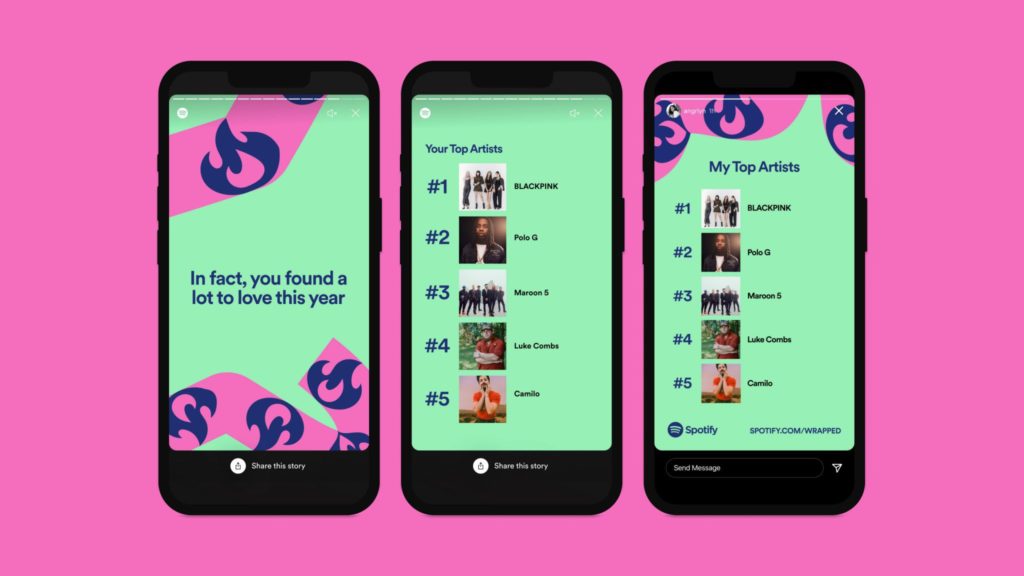
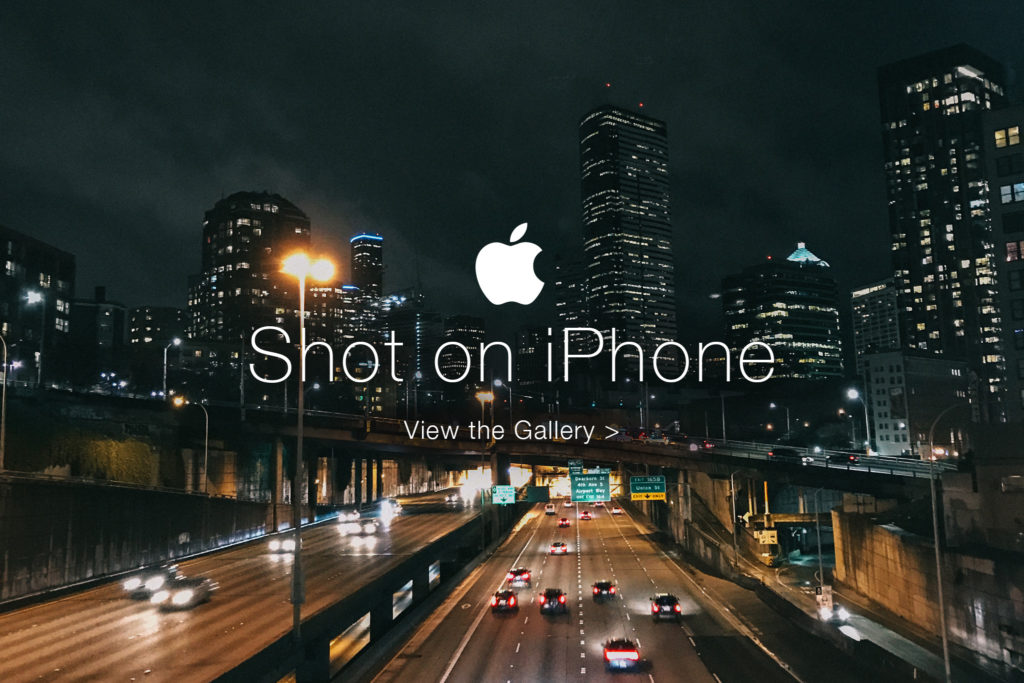
Top 3D design companies
Morrama
Morrama is a product design company. Their small team is London based. The firm offers mostly product design. Morrama provides concept work, prototyping and manufacturing. Morrama is a great example of an effective social media portfolio. Many of their products are displayed very simply and effectively. The white background gives their posts a distinct brand identity.
The Design Laboratory
The Design Laboratory is a London based Design studio specialising in branding. As well as this they provide UX/UI, logo, web, graphic, and product packaging. This company’s social media stood out as it is very personal. They achieved this by posting pictures of all their newly starting staff with descriptions and quotes for each. It was this account that showed me how effective a holiday-related post can be. I found their 3D animated Christmas greeting very charming.
DARCSTUDIO
Darcstudio is an Architectural Visualisation studio founded in 2014 based in Bournemouth. Their work includes hyper-realistic renders of large scale buildings, modern houses and mansions and minimalist modern interiors. Their social media does a great job of illustrating their distinct minimalist style across all of their projects.
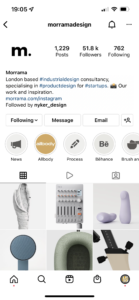
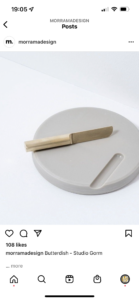
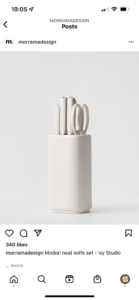
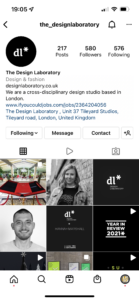
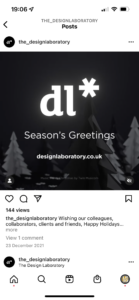
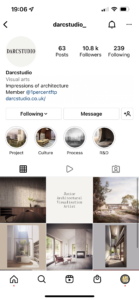
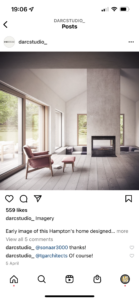
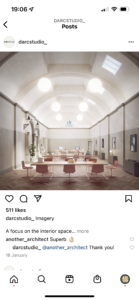
Brainstorming Ideas
Hashtags
After reflecting on some of my research, I knew that using effective hashtags would be important for reaching communities on Instagram and Linkedin. I personally follow a lot of the 3D design related hashtags like #3dmodeling and #3ddesign so I’ll be using them for my posts including my 3D models. For my posts involving Elizabeth Peacock, it will also be valuable to use hashtags like #witchtrials as it will allow me to reach communities like history fans and people who are interested in the history of witches.
The story of Elizabeth Peacock
During my campaign, I plan to upload three posts telling the story of Elizabeth Peacock. These will include posts about different stages in her life. I will also use these posts as a “call to action” to visit my profile to see my 3D interpretation of Elizabeth Peacock’s house. Due to the similarities between these posts, I will be using them to experiment with the best times to upload. I will be uploading one of the three posts earlier in the morning to see the effects it has on the number of accounts I reach.
Project progress
A large portion of my uploads for this campaign will be to post the progress of my group client project for this semester. The goal of my client project is to create a 3D interpretation of Elizabeth Peacock’s home to be used in a virtual reality experience. I’ll be uploading single assets as I create them like pieces of furniture or portions of the house for example the cooking area.
Past projects
I will also be uploading videos and images of my past projects to further show my skills as a 3D designer. These will include projects like the RSA brief from semester one of year 2 and the 3D city project from year one. This will help illustrate to viewers my wider skills across different types of projects. I will also be using Linkedin to upload my past projects and even the projects that I’m currently working on as It will allow me to effectively advertise my skills to potential employers.
Reels
I’ll be using Reels similarly to how I will be using the main timeline. I’ll be uploading videos from my group client project from this semester and also projects from past semesters too. Reels will help me reach a much wider audience with that content due to the algorithm Instagram uses to match users with content that they will enjoy.
Public holiday posts
Based on my research I found that many freelance designers and design studios choose to make uploads on holidays wishing that their viewers have a good day. This is a great way to associate your account with positivity. This format also provides an opportunity to show off 3D skills with an eye-catching 3D background or animation for your message.
Photography/outing
During this semester I have multiple design-related trips planned which will provide plenty of opportunities to gain content for posts. Photography posts provide a new format to show my personality in my campaign. Including photographs of myself will also highlight me as an individual to further personalise my campaign.
Stories
I will be utilising stories for more casual content. Firstly, when I am browsing Instagram I will add posts that I find impressive or interesting, or posts that I feel are closely related to my campaign. I will also be posting casual photo updates showing whatever I am up to with my projects at the time. These may include photos including my laptop screen in a public study area or photos of my desk including my desktop screen. This will further show the development of my projects rather than just the finished results.
Posts
Candle
I would first like to show the reel of my candle. The reel shows a time-lapse of a screen recording of me making the candle model from start to finish and ends by showing the finished product in a beauty render. One of my goals for my social media campaign was to not only show the finished projects of my work but some of the development too. I used this post to demonstrate how effective reels can be for reaching new viewers. The vast majority of the 24 likes I gained on this post were from accounts that didn’t follow me prior to the post. The Instagram reels algorithm was able to effectively broadcast my post to like-minded people. The primary goal of my social media campaign was to reach more accounts and this post allowed me to reach 996. This number of accounts reached dwarfs my other posts and further shows how effective reels are. Earlier in my campaign, I made another post including the same content but optimised it to be a regular post. This post managed to reach only 64 accounts and acts as an interesting experiment showing the effectiveness of reels.
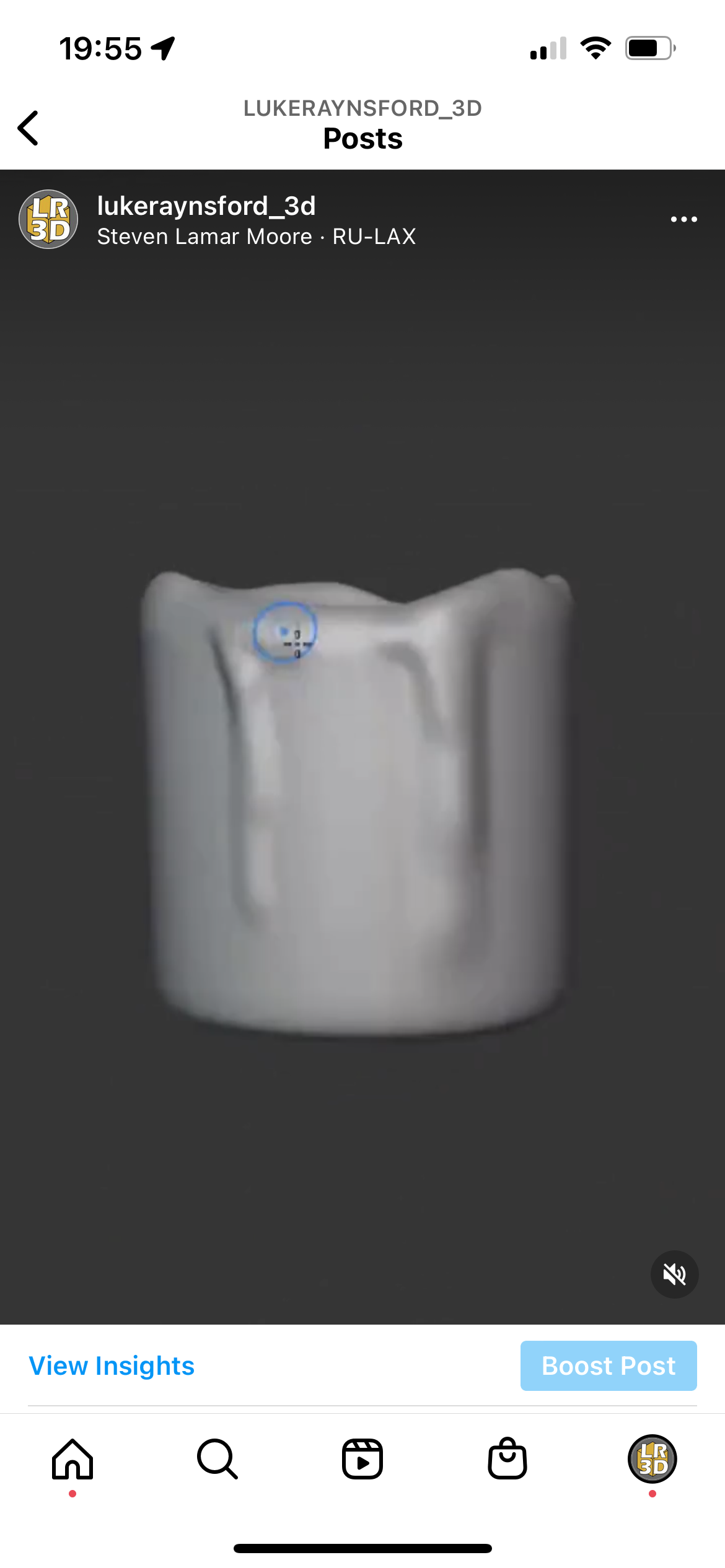
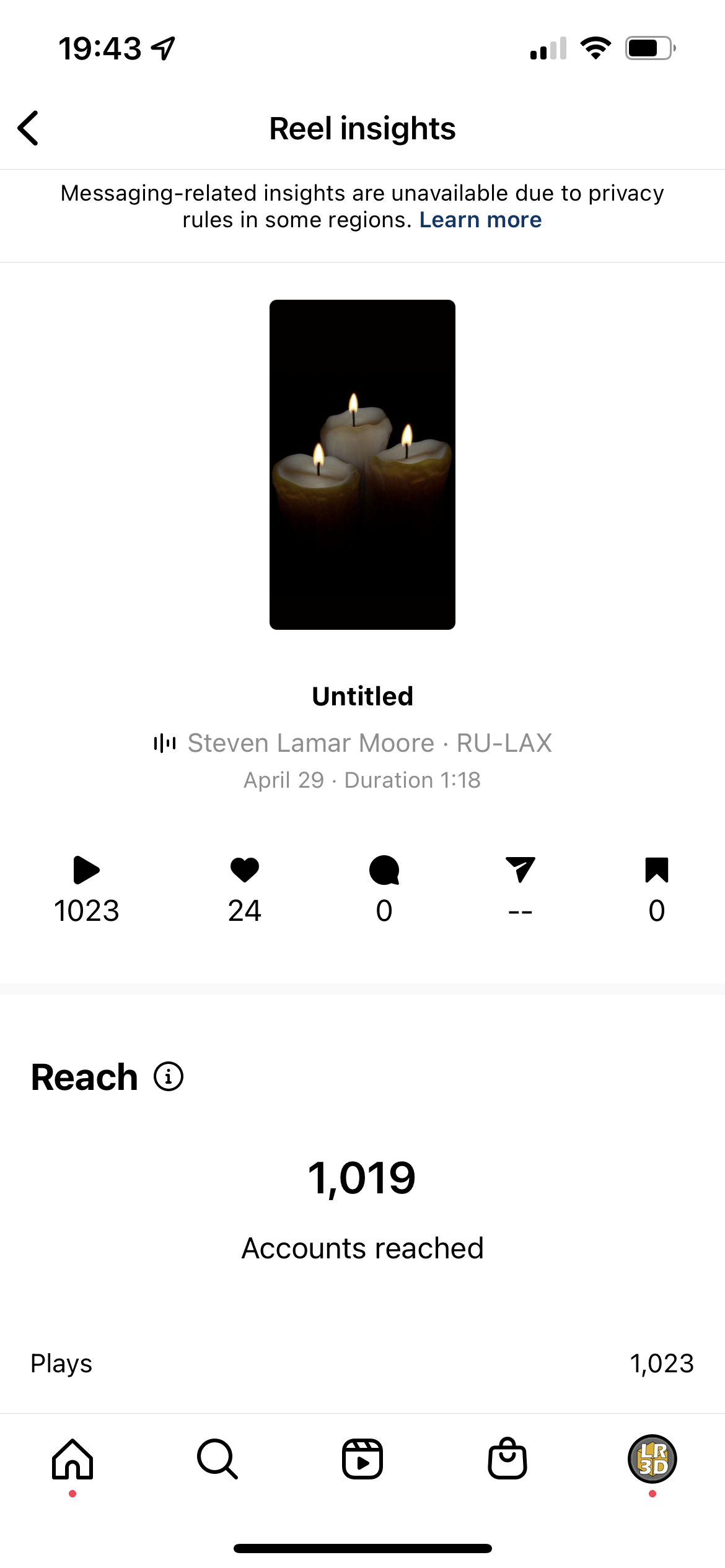

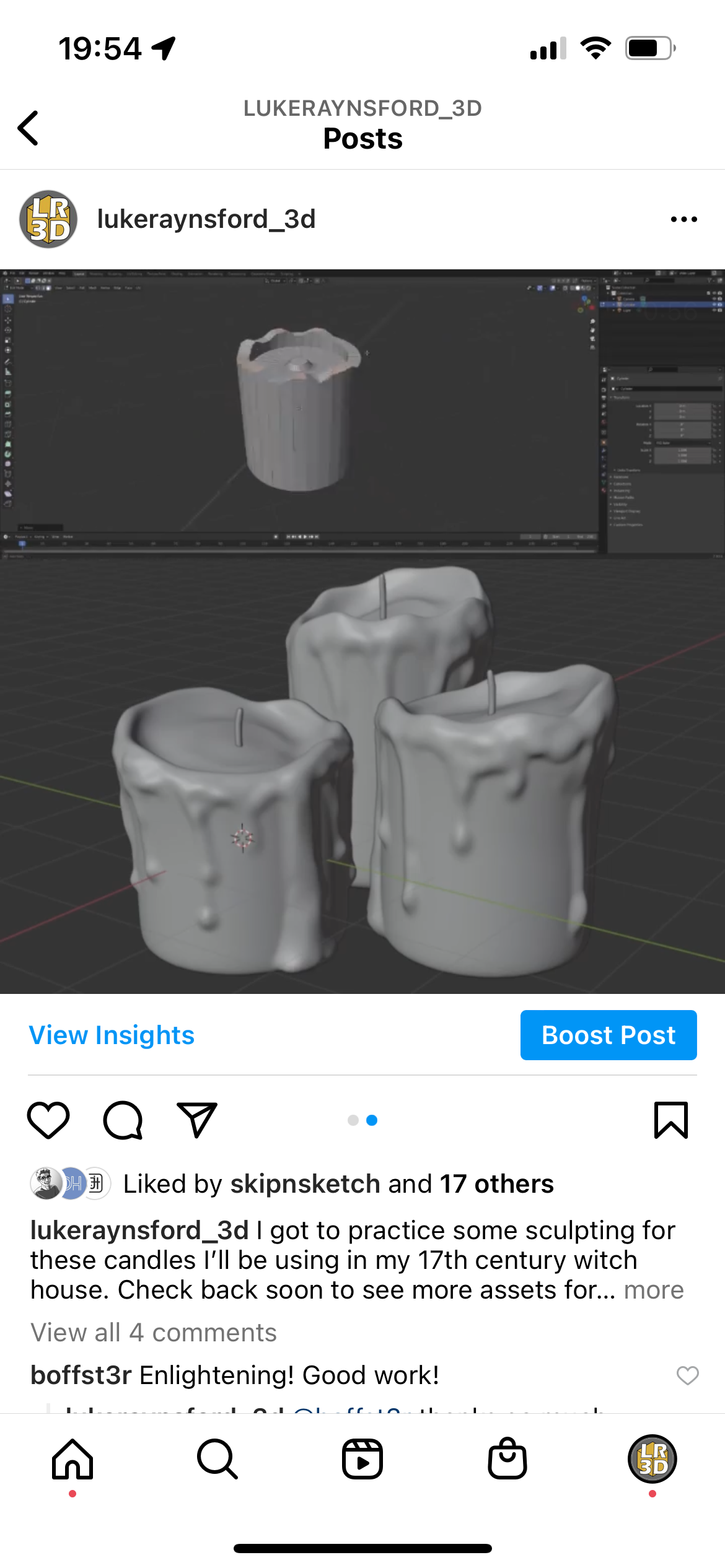

Elizabeth Peacock
I succeeded in making three informational posts about Elizabeth Peacock’s life. The first was an introductory post. This was the first post on my campaign as I thought it would be important for providing context for my client project posts. I then followed that a few weeks later with a post giving information about the various crimes she and her coven were accused of. Lastly, I made a post about her death and her will. Each post included a call to action as the last image in the carousel telling the viewer to visit my profile to see my 3D interpretation of Elizabeth Peacock’s house. This was effective as anyone who read all of the information in these posts is likely to be interested in my Elizabeth Peacock related 3D work. I immediately realised that having a recognisable brand identity across my whole campaign would be difficult as a 3D student as most of my content was uploads of different projects each with different styles so I knew it would be important to be consistent across my three posts. I started with the colour scheme for my personal brand (grey with yellow accents) but it didn’t fit the content. Most of the drawings and artwork I could find relating to 17th-century witchcraft were coloured in light beige to give the effect of old paper. I found this colour to be suitable for the typography across these posts. As mentioned before, I used these posts to test the most suitable time to upload due to the similar content across these posts. With my first post, I was able to reach 61 accounts and 40 non-followers by posting at 5 in the afternoon. For my second post about the crimes of Elizabeth Peacock, I chose to post in the morning at 10 AM. For this post, I was only able to reach 39 accounts and only 13 non-followers. After this dip in accounts reached, for my third post about Elizabeth Peacock’s death I went back to posting at 5 PM. The number of accounts I reached went back up to 55, 31 of which were non-followers. This confirmed that the best time to post was in the mid-afternoon.
Post 1

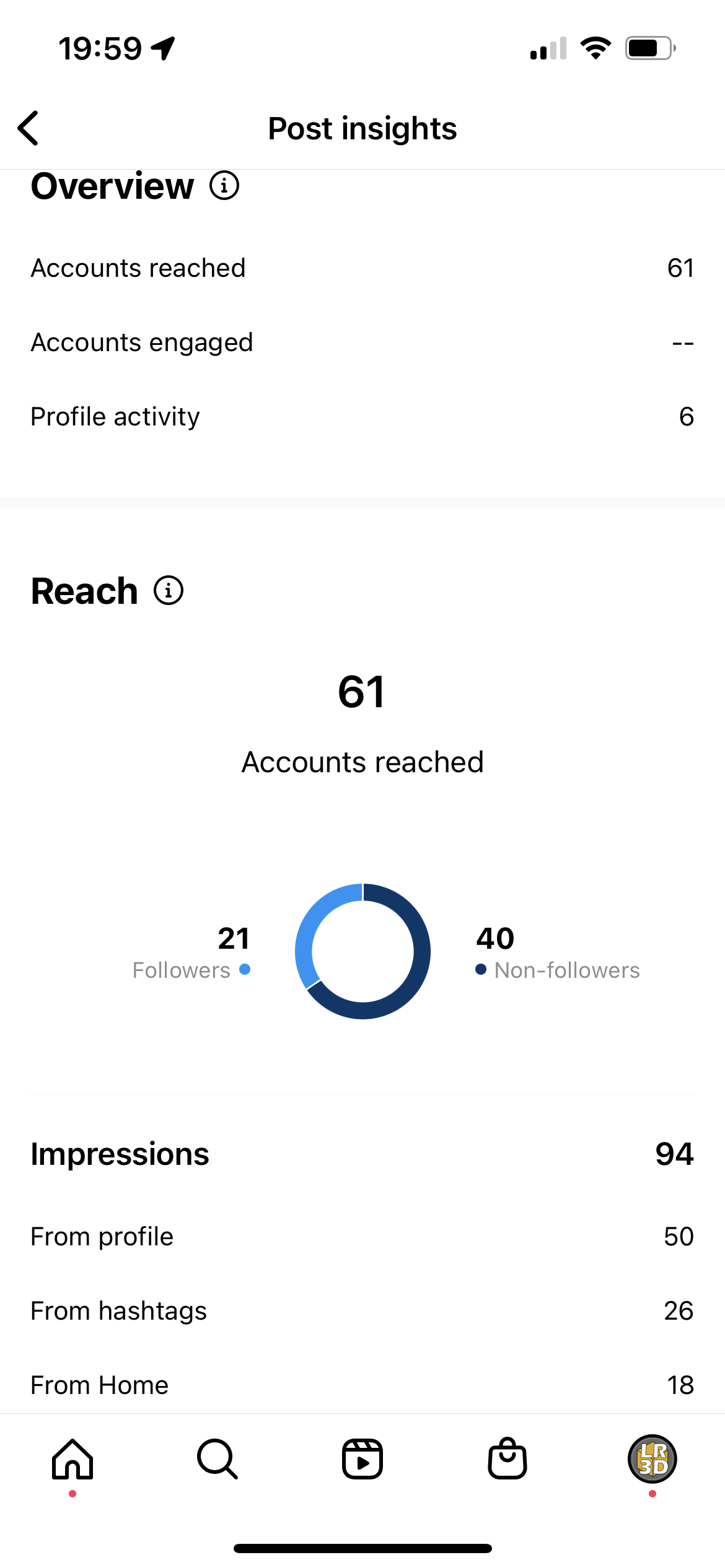
Post 2


Post 3
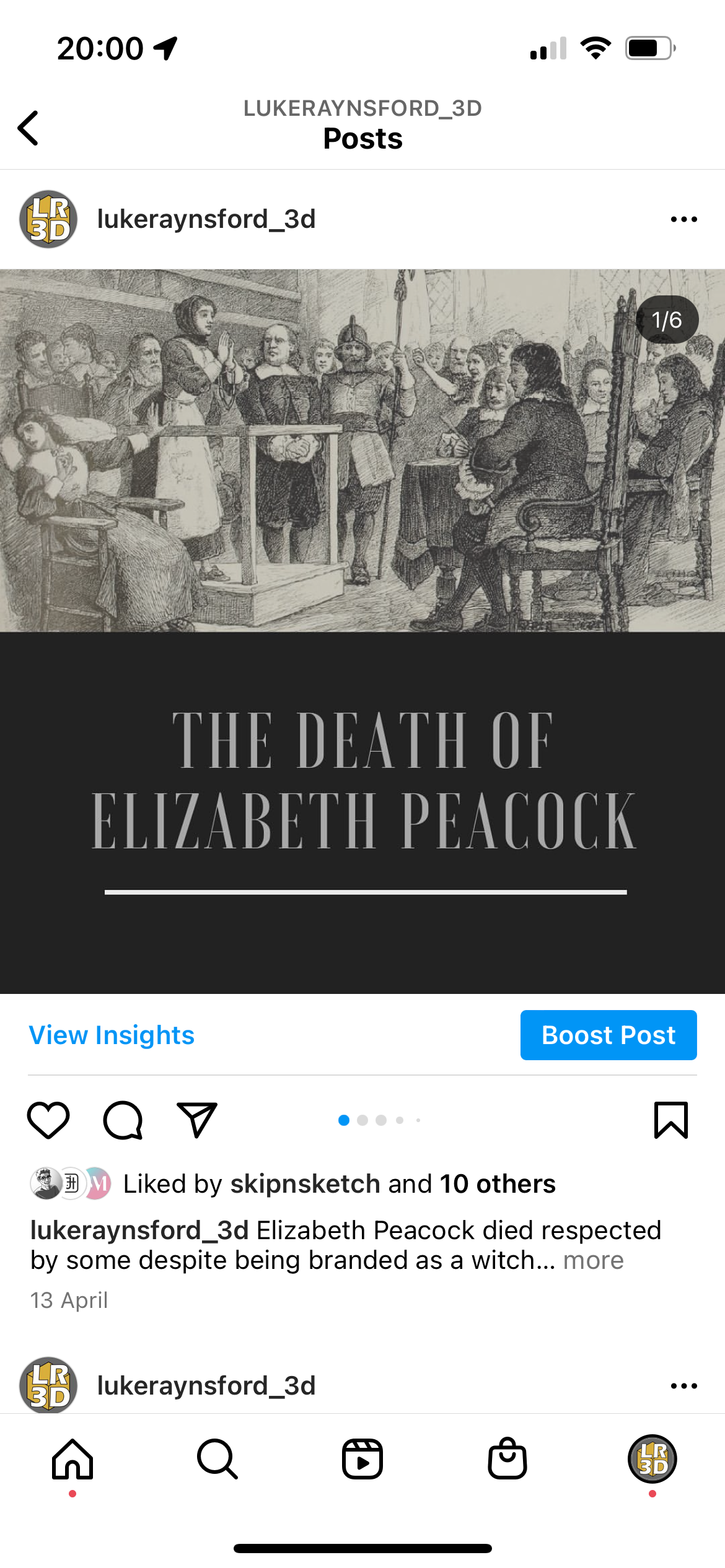
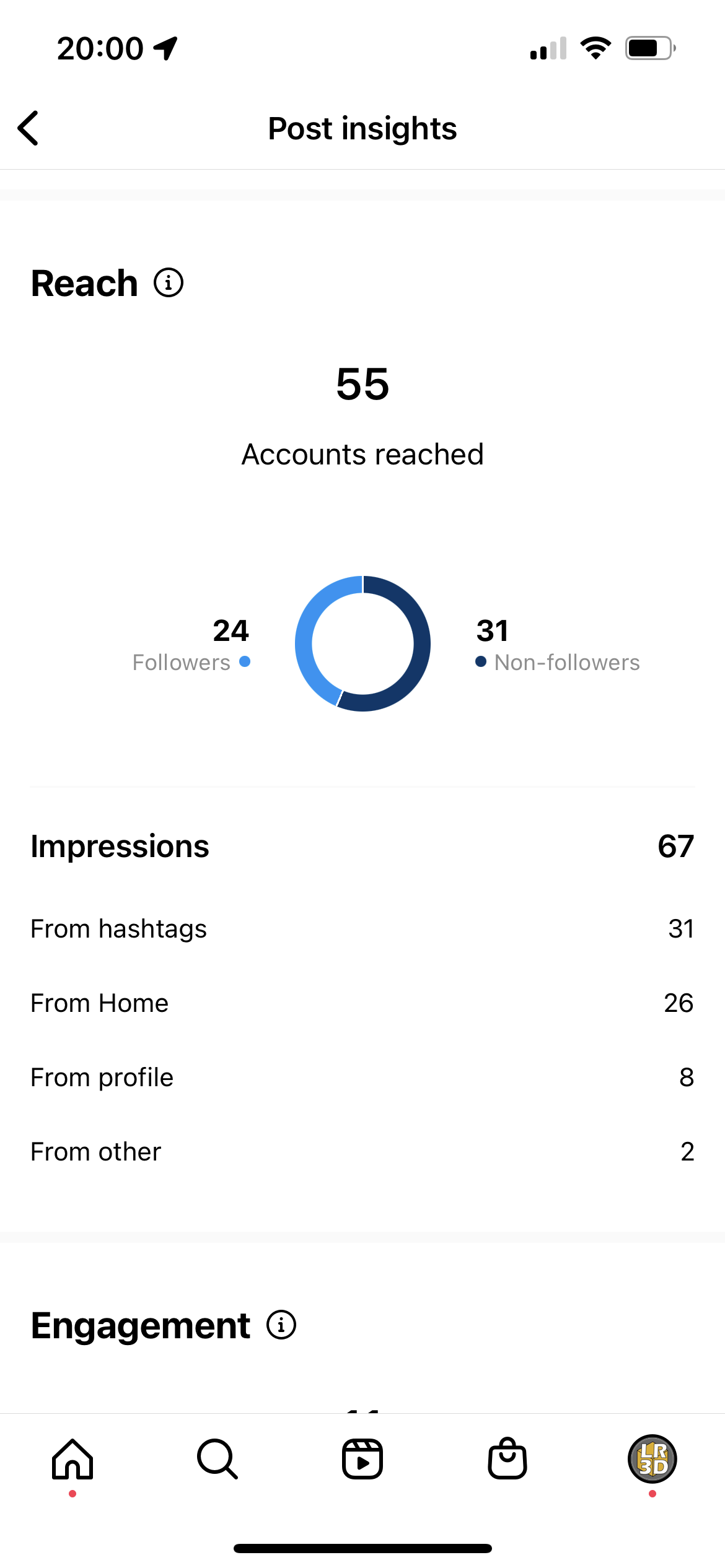
Exterior render
My post displaying the exterior of Elizabeth Peacock’s house was my most successful post. This post is made up of a series of images showing the model at different angles including a close up showing the details of the textures I produced. In the last image, I showed the original concept for the exterior before I received feedback from my client to show some of the processes that went into making the model. In total this post reached 109 accounts, 85 of which were not previously followers. This post showed how effective appropriate hashtags are. 74 of my 138 impressions on this post were from hashtags. This post also lead 5 people to my profile. This post also taught me it would be more effective to make more posts with less content in each. Posting more content will allow me to reach more accounts. Although this post did very well for one post, it would have translated very well into three or more posts that together would have done even better.
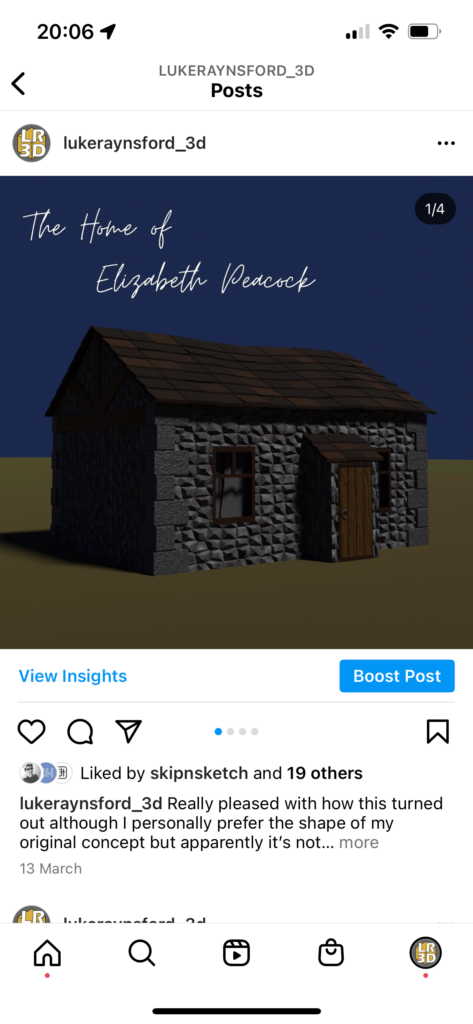
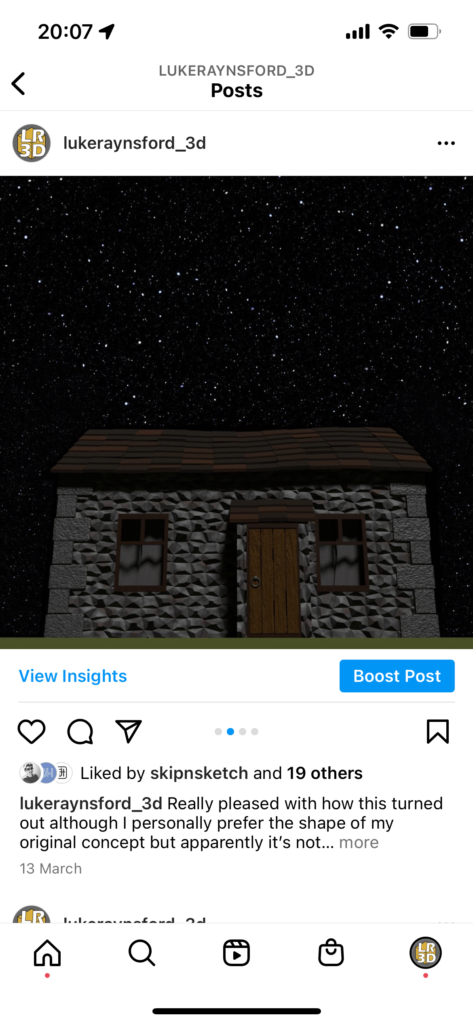
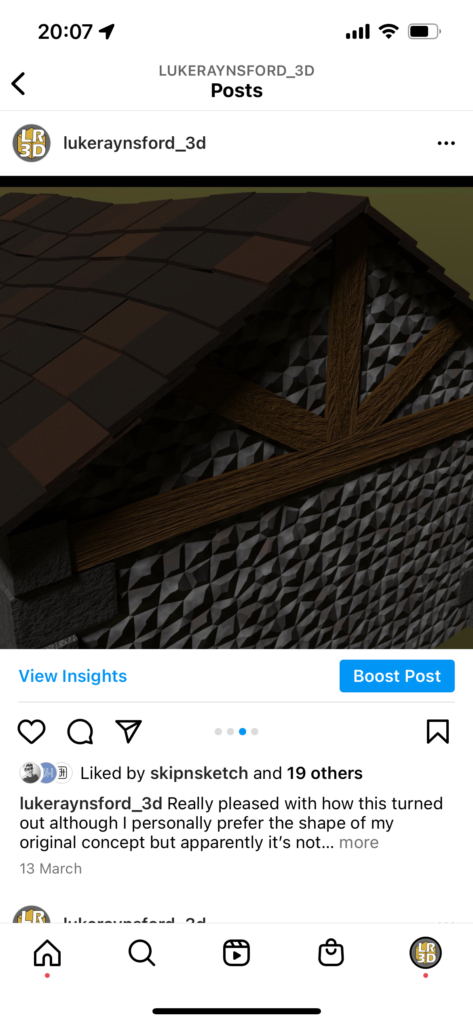
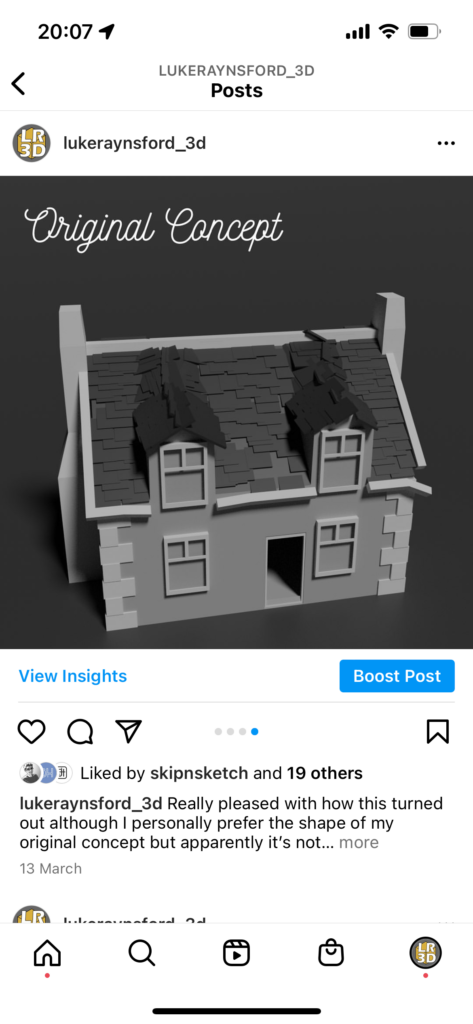

St Patrick’s day
For my St Patrick’s day post I included a message wishing people a happy day. For this message, I produced a background made up of a blanket of 3D clovers covering the whole image. I also made an alternate green version of my personal logo to include in the corner of the post. For this post, I used fewer hashtags which I think is the cause of the dip in popularity. Only 3 people found this post using hashtags which is very poor compared to the 74 impressions I received through hashtags for my house exterior post as mentioned above. Despite this, I still feel that this post is valuable to my campaign as a whole. This post associates my account with positivity and provides a change in content to stop the campaign from becoming repetitive.
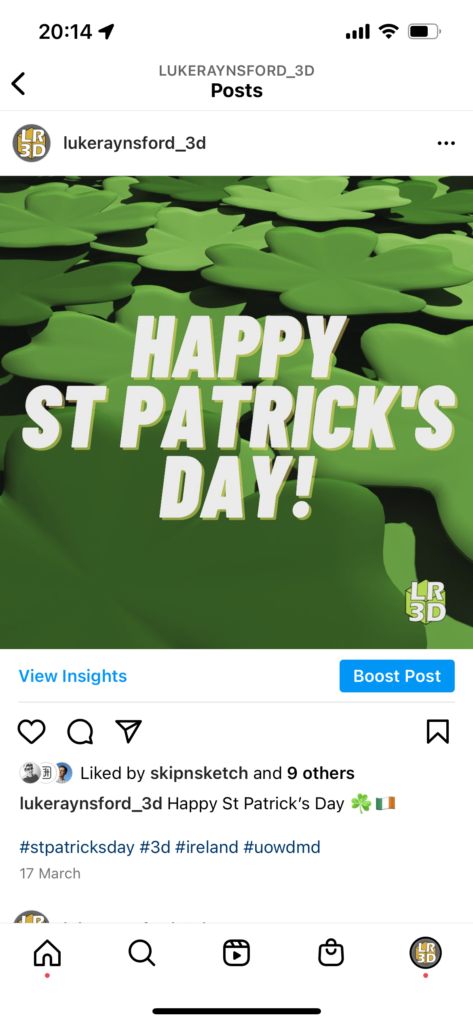
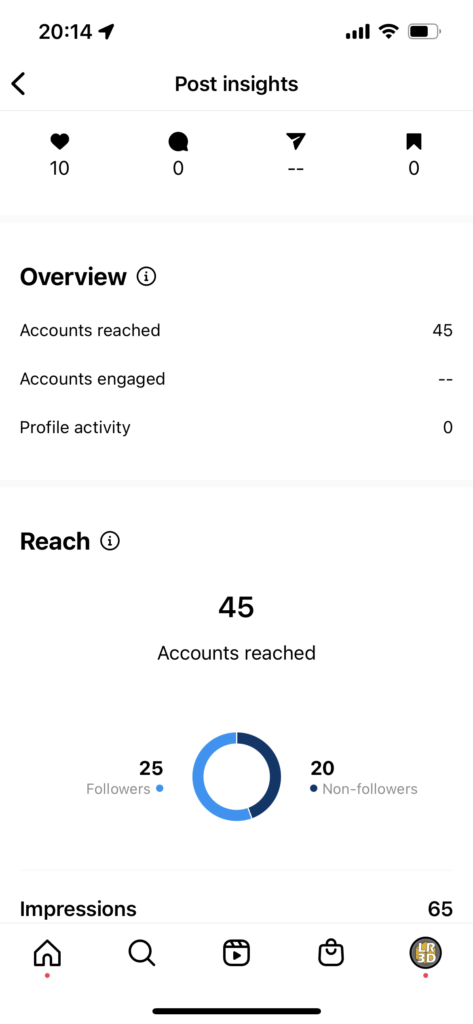
Bed and Cabinet
During my campaign, my posts including work from my Elizabeth Peacock house attracted the most interest through comments. One viewer saw my post showing my bed asset and asked what software I had been using to produce my work. I then was able to reply with a detailed answer about what software I use and why I use it. Another post that attracted comments was the one showing the cabinet for my Elizabeth Peacock house. On this post, I received a comment from Campbell Ritchie who works for Explore Malmesbury. He very kindly provided additional information relating to the furniture found in Elizabeth Peacock’s house.

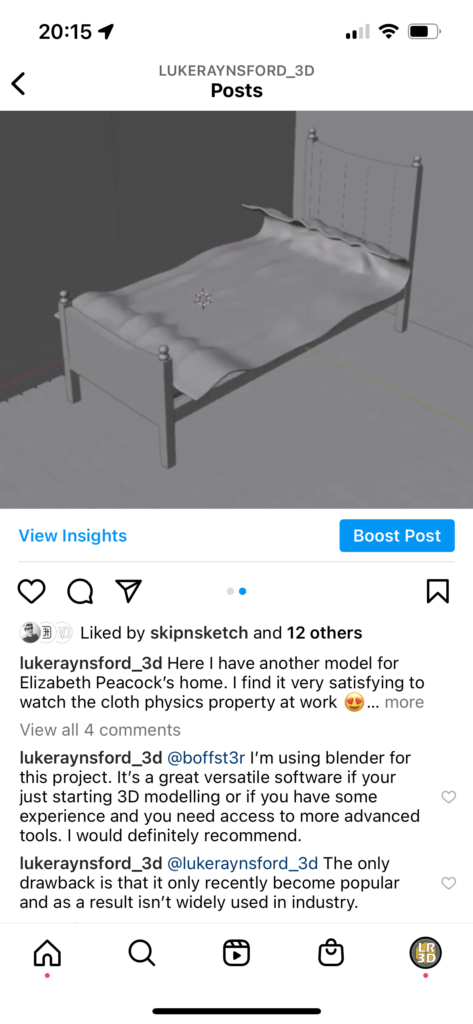
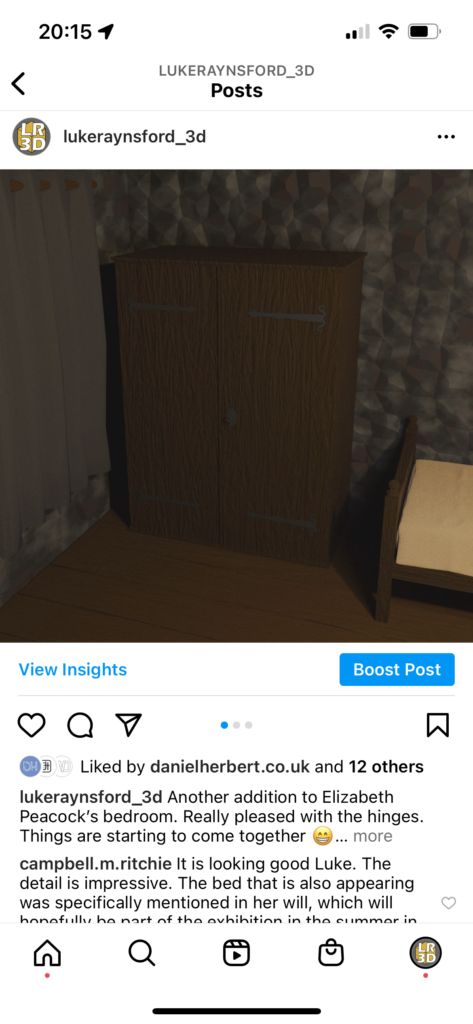
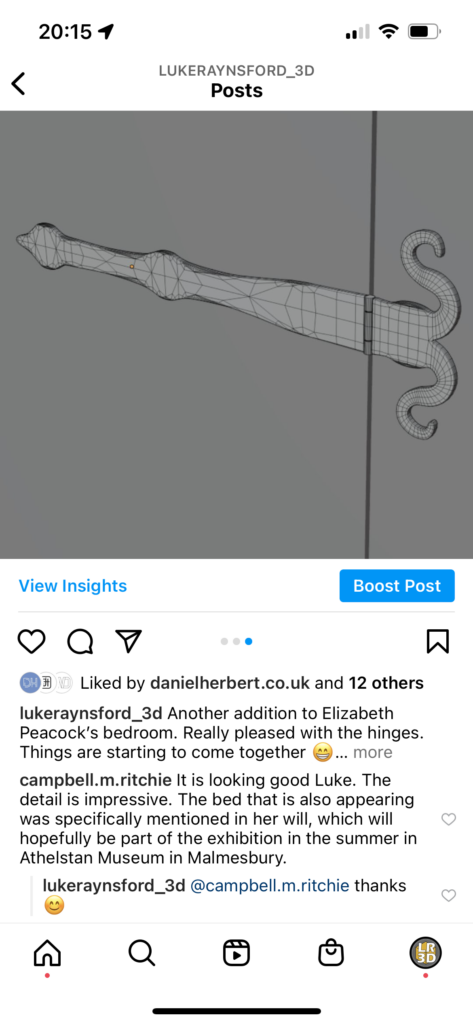
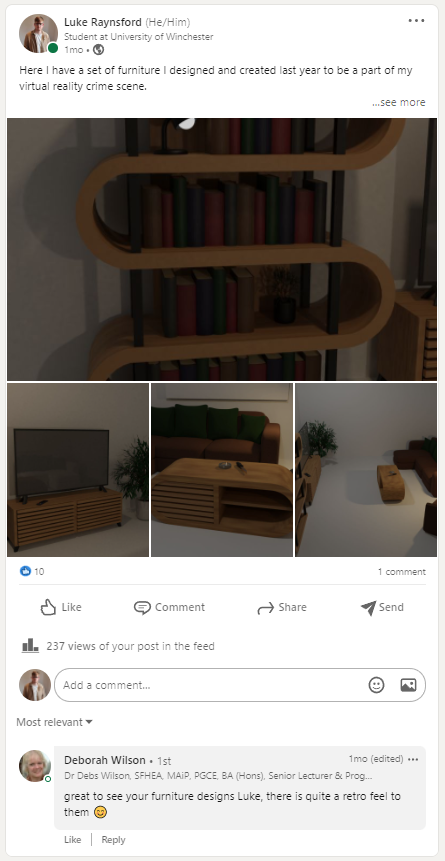
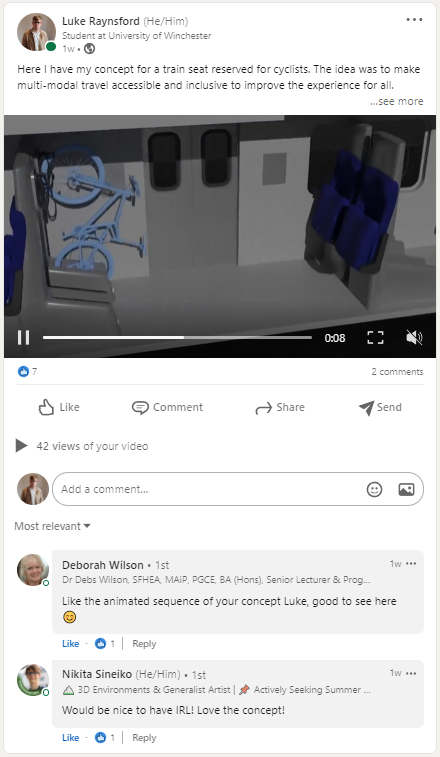
Stories
At the time of writing, I made 10 story posts on Instagram. These are made up of two types of stories, other people’s uploads that left an impression on me and posts showing what I was up to myself. To keep my update stories on topic, most of them showed whatever I was working on at the time. To make the stories more personal I also played whatever song I was listening to over the story. Most of these stories received similar levels of success with a few exceptions. Each story received similar amounts of impressions ranging between 15 and 20 with no clear pattern. The top four most popular posts were evenly split between my two types of stories.
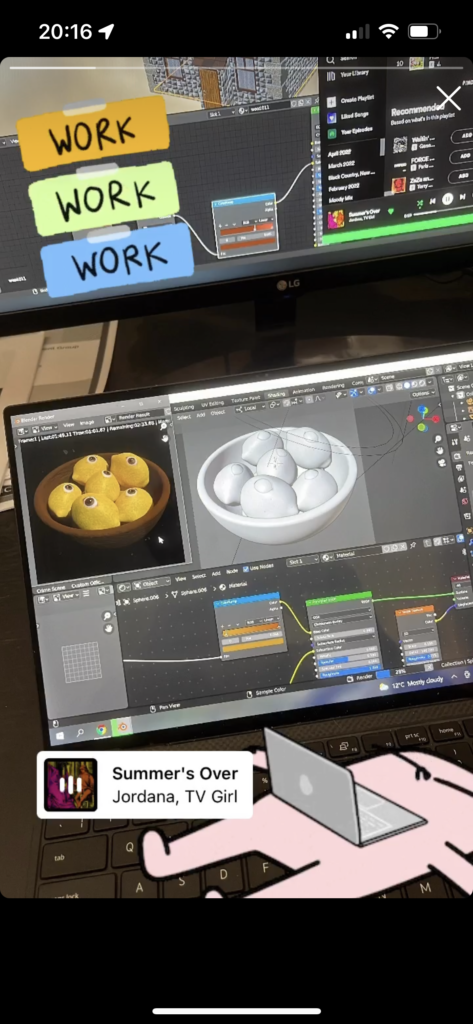
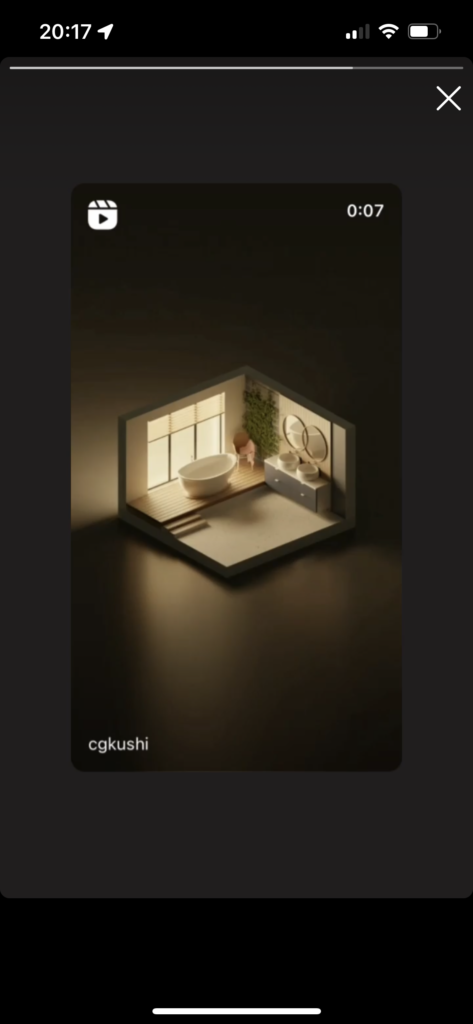
Reflection
Looking back at this project as a whole I am happy with the finished product but there are a few changes I would make to the process of getting there. I find it difficult to feel comfortable on social media and as a result was hesitant to begin the planning stage of my campaign. In the timeframe I gave myself, I was able to plan the types of posts I would be uploading amongst other research but I failed to consider the importance of making a timeline of uploads and planning exactly what I would post when. I feel that this resulted in a more disjointed campaign and also caused me a lot of unnecessary stress after the planning portion of this project. This experience taught me how much easier a comprehensive, timeline plan can make a project and also how much it can improve the final result.
I would also like to make more posts with less content in each. Posting more content will allow me to reach more accounts. After reviewing my profile I noticed that having more single-image posts would be more effective than having fewer posts with 4 or more images in a carousel.
Another improvement I will make is to use Reels more frequently. During the campaign, I found that old videos I had made for past projects did not translate to the Reels format well. Going forward I will consider how a video would translate to a Reel before making them.
It will also be very important to interact more on LinkedIn. I found using Linkedin alien to me and I feel that my interactions took a hit as a result. Going forward I will take steps to improve my ability on Linkedin. Lastly, I would like to include pictures of myself and what I do in real life rather than just digital content. This will help further connect me as a person to my online brand.
